Abstract
Dicer is an RNase III enzyme essential for the maturation of the majority of microRNAs. Recent studies have revealed downregulation or hemizygous loss of Dicer in many tumor models and demonstrated that suppressing Dicer activity enhances tumorigenic activities of lung and breast cancer cells, which support Dicer as a haploinsufficient tumor suppressor in these cancer models. Surprisingly, we found that knocking down Dicer expression suppresses the growth and tumorigenic capacity of human prostate cancer cell lines, but enhances migratory capacities of some prostate cancer cell lines. Dicer is upregulated in human prostate cancer specimens, but lower Dicer expression portends a shorter time to recurrence. Complete ablation of Dicer activity in a Pten null mouse model for prostate cancer significantly halts tumor growth and progression, demonstrating that microRNAs have a critical role in maintaining cancer cell fitness. In comparison, hemizygous loss of Dicer in the same model also reduces primary tumor burden, but induces a more locally invasive phenotype and causes seminal vesicle obstruction at high penetrance. Disrupting Dicer activity leads to an increase in apoptosis and senescence in these models, presumably through upregulation of P16/INK4a and P27/Kip1. Collectively, these results highlight a pleotropic role of Dicer in tumorigenesis that is not only dosage-dependent but also tissue context-dependent.
This is a preview of subscription content, access via your institution
Access options
Subscribe to this journal
Receive 50 print issues and online access
$259.00 per year
only $5.18 per issue
Buy this article
- Purchase on Springer Link
- Instant access to full article PDF
Prices may be subject to local taxes which are calculated during checkout






Similar content being viewed by others
References
Harfe BD, McManus MT, Mansfield JH, Hornstein E, Tabin CJ . The RNaseIII enzyme Dicer is required for morphogenesis but not patterning of the vertebrate limb. Proc Natl Acad Sci USA 2005; 102: 10898–10903.
Nakagawa A, Shi Y, Kage-Nakadai E, Mitani S, Xue D . Caspase-dependent conversion of Dicer ribonuclease into a death-promoting deoxyribonuclease. Science 2010; 328: 327–334.
Yi R, O'Carroll D, Pasolli HA, Zhang Z, Dietrich FS, Tarakhovsky A et al. Morphogenesis in skin is governed by discrete sets of differentially expressed microRNAs. Nat Genet 2006; 38: 356–362.
Andl T, Murchison EP, Liu F, Zhang Y, Yunta-Gonzalez M, Tobias JW et al. The miRNA-processing enzyme dicer is essential for the morphogenesis and maintenance of hair follicles. Curr Biol 2006; 16: 1041–1049.
Kanellopoulou C, Muljo SA, Kung AL, Ganesan S, Drapkin R, Jenuwein T et al. Dicer-deficient mouse embryonic stem cells are defective in differentiation and centromeric silencing. Genes & Develop 2005; 19: 489–501.
Koralov SB, Muljo SA, Galler GR, Krek A, Chakraborty T, Kanellopoulou C et al. Dicer ablation affects antibody diversity and cell survival in the B lymphocyte lineage. Cell 2008; 132: 860–874.
Mudhasani R, Zhu Z, Hutvagner G, Eischen CM, Lyle S, Hall LL et al. Loss of miRNA biogenesis induces p19Arf-p53 signaling and senescence in primary cells. J Cell Biol 2008; 181: 1055–1063.
Xu S, Guo K, Zeng Q, Huo J, Lam KP . The RNase III enzyme Dicer is essential for germinal center B-cell formation. Blood 2012; 119: 767–776.
O'Rourke JR, Georges SA, Seay HR, Tapscott SJ, McManus MT, Goldhamer DJ et al. Essential role for Dicer during skeletal muscle development. Develop Biol 2007; 311: 359–368.
Pastorelli LM, Wells S, Fray M, Smith A, Hough T, Harfe BD et al. Genetic analyses reveal a requirement for Dicer1 in the mouse urogenital tract. Mamm Genome 2009; 20: 140–151.
Zhang L, Zhang B, Valdez JM, Wang F, Ittmann M, Xin L . Dicer ablation impairs prostate stem cell activity and causes prostate atrophy. Stem Cells 2010; 28: 1260–1269.
Lu J, Getz G, Miska EA, Alvarez-Saavedra E, Lamb J, Peck D et al. MicroRNA expression profiles classify human cancers. Nature 2005; 435: 834–838.
Jafarnejad SM, Ardekani GS, Ghaffari M, Martinka M, Li G . Sox4-mediated Dicer expression is critical for suppression of melanoma cell invasion. Oncogene 2012; 32: 2131–2139.
Lin RJ, Lin YC, Chen J, Kuo HH, Chen YY, Diccianni MB et al. microRNA signature and expression of Dicer and Drosha can predict prognosis and delineate risk groups in neuroblastoma. Cancer Res 2010; 70: 7841–7850.
Khoshnaw SM, Rakha EA, Abdel-Fatah TM, Nolan CC, Hodi Z, Macmillan DR et al. Loss of Dicer expression is associated with breast cancer progression and recurrence. Breast Cancer Res Treat 2012; 135: 403–413.
Grelier G, Voirin N, Ay AS, Cox DG, Chabaud S, Treilleux I et al. Prognostic value of Dicer expression in human breast cancers and association with the mesenchymal phenotype. Br J Cancer 2009; 101: 673–683.
Noh H, Hong S, Dong Z, Pan ZK, Jing Q, Huang S . Impaired microrna processing facilitates breast cancer cell invasion by upregulating urokinase-type plasminogen activator expression. Genes & Cancer 2011; 2: 140–150.
Chiosea S, Jelezcova E, Chandran U, Luo J, Mantha G, Sobol RW et al. Overexpression of Dicer in precursor lesions of lung adenocarcinoma. Cancer Res 2007; 67: 2345–2350.
Karube Y, Tanaka H, Osada H, Tomida S, Tatematsu Y, Yanagisawa K et al. Reduced expression of Dicer associated with poor prognosis in lung cancer patients. Cancer Sci 2005; 96: 111–115.
Faggad A, Budczies J, Tchernitsa O, Darb-Esfahani S, Sehouli J, Muller BM et al. Prognostic significance of Dicer expression in ovarian cancer-link to global microRNA changes and oestrogen receptor expression. J Pathol 2010; 220: 382–391.
Merritt WM, Lin YG, Han LY, Kamat AA, Spannuth WA, Schmandt R et al. Dicer, Drosha, and outcomes in patients with ovarian cancer. N Engl J Med 2008; 359: 2641–2650.
Kumar MS, Pester RE, Chen CY, Lane K, Chin C, Lu J et al. Dicer1 functions as a haploinsufficient tumor suppressor. Genes & Develop 2009; 23: 2700–2704.
Kumar MS, Lu J, Mercer KL, Golub TR, Jacks T . Impaired microRNA processing enhances cellular transformation and tumorigenesis. Nat Genet 2007; 39: 673–677.
Lambertz I, Nittner D, Mestdagh P, Denecker G, Vandesompele J, Dyer MA et al. Monoallelic but not biallelic loss of Dicer1 promotes tumorigenesis in vivo. Cell Death Differ 2010; 17: 633–641.
Arrate MP, Vincent T, Odvody J, Kar R, Jones SN, Eischen CM . MicroRNA biogenesis is required for Myc-induced B-cell lymphoma development and survival. Cancer Res 2010; 70: 6083–6092.
Volinia S, Calin GA, Liu CG, Ambs S, Cimmino A, Petrocca F et al. A microRNA expression signature of human solid tumors defines cancer gene targets. Proc Natl Acad Sci USA 2006; 103: 2257–2261.
Ozen M, Creighton CJ, Ozdemir M, Ittmann M . Widespread deregulation of microRNA expression in human prostate cancer. Oncogene 2008; 27: 1788–1793.
Ambs S, Prueitt RL, Yi M, Hudson RS, Howe TM, Petrocca F et al. Genomic profiling of microRNA and messenger RNA reveals deregulated microRNA expression in prostate cancer. Cancer Res 2008; 68: 6162–6170.
Chiosea S, Jelezcova E, Chandran U, Acquafondata M, McHale T, Sobol RW et al. Up-regulation of dicer, a component of the MicroRNA machinery, in prostate adenocarcinoma. Am J Pathol 2006; 169: 1812–1820.
Nittner D, Lambertz I, Clermont F, Mestdagh P, Kohler C, Nielsen SJ et al. Synthetic lethality between Rb, p53 and Dicer or miR-17-92 in retinal progenitors suppresses retinoblastoma formation. Nat Cell Biol 2012; 14: 958–965.
Ravi A, Gurtan AM, Kumar MS, Bhutkar A, Chin C, Lu V et al. Proliferation and tumorigenesis of a murine sarcoma cell line in the absence of DICER1. Cancer Cell 2012; 21: 848–855.
Taylor BS, Schultz N, Hieronymus H, Gopalan A, Xiao Y, Carver BS et al. Integrative genomic profiling of human prostate cancer. Cancer Cell 2010; 18: 11–22.
Jin C, McKeehan K, Wang F . Transgenic mouse with high Cre recombinase activity in all prostate lobes, seminal vesicle, and ductus deferens. Prostate 2003; 57: 160–164.
Wang S, Gao J, Lei Q, Rozengurt N, Pritchard C, Jiao J et al. Prostate-specific deletion of the murine Pten tumor suppressor gene leads to metastatic prostate cancer. Cancer Cell 2003; 4: 209–221.
Park JH, Walls JE, Galvez JJ, Kim M, Abate-Shen C, Shen MM et al. Prostatic intraepithelial neoplasia in genetically engineered mice. Am J Pathol 2002; 161: 727–735.
Chen Z, Trotman LC, Shaffer D, Lin HK, Dotan ZA, Niki M et al. Crucial role of p53-dependent cellular senescence in suppression of Pten-deficient tumorigenesis. Nature 2005; 436: 725–730.
Alimonti A, Nardella C, Chen Z, Clohessy JG, Carracedo A, Trotman LC et al. A novel type of cellular senescence that can be enhanced in mouse models and human tumor xenografts to suppress prostate tumorigenesis. J Clin Invest 2010; 120: 681–693.
Tang KF, Ren H, Cao J, Zeng GL, Xie J, Chen M et al. Decreased Dicer expression elicits DNA damage and up-regulation of MICA and MICB. J Cell Biol 2008; 182: 233–239.
Wei W, Ba Z, Gao M, Wu Y, Ma Y, Amiard S et al. A role for small RNAs in DNA double-strand break repair. Cell 2012; 149: 101–112.
Francia S, Michelini F, Saxena A, Tang D, de Hoon M, Anelli V et al. Site-specific DICER and DROSHA RNA products control the DNA-damage response. Nature 2012; 488: 231–235.
Ma Z, Swede H, Cassarino D, Fleming E, Fire A, Dadras SS . Up-regulated Dicer expression in patients with cutaneous melanoma. PLoS One 2011; 6: e20494.
Kim J, Coffey DM, Creighton CJ, Yu Z, Hawkins SM, Matzuk MM . High-grade serous ovarian cancer arises from fallopian tube in a mouse model. Proc Natl Acad Sci USA 2012; 109: 3921–3926.
Ting AH, Suzuki H, Cope L, Schuebel KE, Lee BH, Toyota M et al. A requirement for DICER to maintain full promoter CpG island hypermethylation in human cancer cells. Cancer Res 2008; 68: 2570–2575.
Yu JY, Reynolds SH, Hatfield SD, Shcherbata HR, Fischer KA, Ward EJ et al. Dicer-1-dependent Dacapo suppression acts downstream of Insulin receptor in regulating cell division of Drosophila germline stem cells. Development 2009; 136: 1497–1507.
Majumder PK, Grisanzio C, O'Connell F, Barry M, Brito JM, Xu Q et al. A prostatic intraepithelial neoplasia-dependent p27 Kip1 checkpoint induces senescence and inhibits cell proliferation and cancer progression. Cancer Cell 2008; 14: 146–155.
Han L, Zhang A, Zhou X, Xu P, Wang GX, Pu PY et al. Downregulation of Dicer enhances tumor cell proliferation and invasion. Int J Oncol 2010; 37: 299–305.
Martello G, Rosato A, Ferrari F, Manfrin A, Cordenonsi M, Dupont S et al. A MicroRNA targeting dicer for metastasis control. Cell 2010; 141: 1195–1207.
Narayanan R, Jiang J, Gusev Y, Jones A, Kearbey JD, Miller DD et al. MicroRNAs are mediators of androgen action in prostate and muscle. PLoS One 2010; 5: e13637.
Sun Y, Wang BE, Leong KG, Yue P, Li L, Jhunjhunwala S et al. Androgen deprivation causes epithelial-mesenchymal transition in the prostate: implications for androgen-deprivation therapy. Cancer Res 2012; 72: 527–536.
Xin L, Ide H, Kim Y, Dubey P, Witte ON . In vivo regeneration of murine prostate from dissociated cell populations of postnatal epithelia and urogenital sinus mesenchyme. Proc Natl Acad Sci USA 2003; 100 (Suppl 1): 11896–11903.
Shlush LI, Itzkovitz S, Cohen A, Rutenberg A, Berkovitz R, Yehezkel S et al. Quantitative digital in situ senescence-associated beta-galactosidase assay. BMC Cell Biol 2011; 12: 16.
Acknowledgements
We thank Drs Lawrence Donehower and Jeffrey Rosen for critical comments, Dr Xiongbin Lu for sharing reagents. This work is supported by NIH R00 CA125937 (LX), Cancer Prevention Research Institute of Texas RP110005 (LX), NIH U01 CA141497 (MMI), and NIH P30 CA125123 (PI: Kent Osborne). This study was supported by National Cancer Institute, Cancer Prevention and Research Institute of Texas.
Author information
Authors and Affiliations
Corresponding author
Ethics declarations
Competing interests
The authors declare no conflict of interest.
Additional information
Supplementary Information accompanies this paper on the Oncogene website
Supplementary information
Rights and permissions
About this article
Cite this article
Zhang, B., Chen, H., Zhang, L. et al. A dosage-dependent pleiotropic role of Dicer in prostate cancer growth and metastasis. Oncogene 33, 3099–3108 (2014). https://doi.org/10.1038/onc.2013.281
Received:
Revised:
Accepted:
Published:
Issue Date:
DOI: https://doi.org/10.1038/onc.2013.281
Keywords
This article is cited by
-
Induction of RAC1 protein translation and MKK7/JNK-dependent autophagy through dicer/miR-145/SOX2/miR-365a axis contributes to isorhapontigenin (ISO) inhibition of human bladder cancer invasion
Cell Death & Disease (2022)
-
Global miRNA dosage control of embryonic germ layer specification
Nature (2021)
-
Pten and Dicer1 loss in the mouse uterus causes poorly differentiated endometrial adenocarcinoma
Oncogene (2020)
-
Expressional profiling and clinical relevance of RNase κ in prostate cancer: a novel indicator of favorable progression-free survival
Journal of Cancer Research and Clinical Oncology (2018)
-
Genetic variants in RNA-induced silencing complex genes and prostate cancer
World Journal of Urology (2017)



